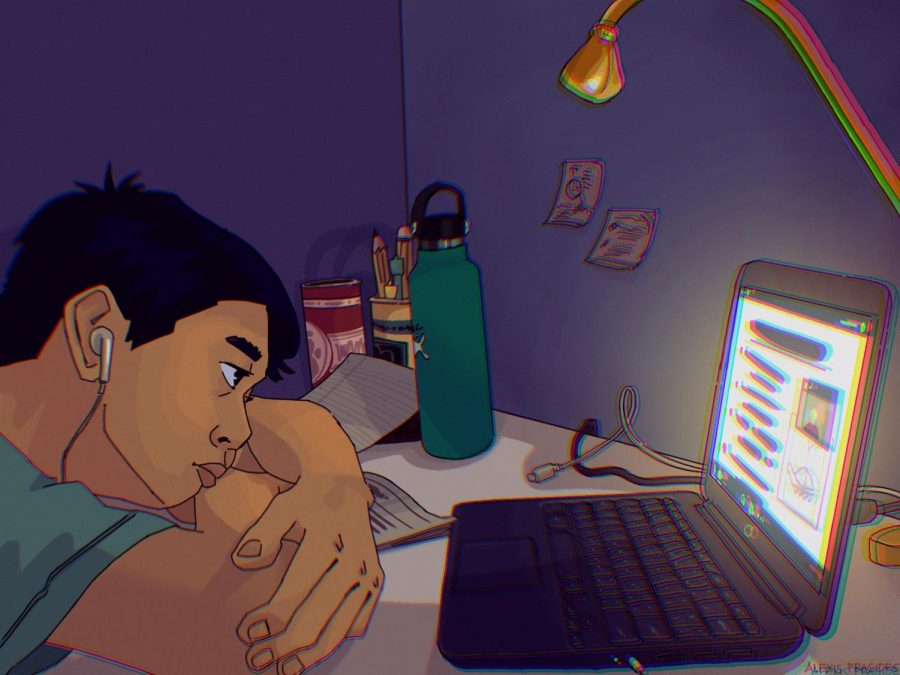‘ZZZ’oom meetings: Online learning and its effect on students’ fatigue
Zoom fatigue has caused students to become less engaged with their online classes.
Since the switch to remote learning began at the start of the school year, many students have begun to feel a new type of weariness—Zoom fatigue. Zoom fatigue refers to the tiredness one may feel because of constant classes via Zoom throughout the school day. Whether from lack of sleep or boredom with certain classes, this feeling is completely new to students and poses a challenge in combating exhaustion in a time in which all learning is done digitally.
Due to all remote learning, students must take all their classes virtually; this means staring at a screen for hours, five days a week. Senior Domani Sharkey explains how she feels at the end of a school day.
“I definitely think by the end of the day it’s like I’ve been bombarded by Zoom calls over and over again, and then at that point [by the end of the school day], I’m exhausted of them. I’d say my fatigue is more gradual as the school day moves along,” Sharkey said.
These constant streams of Zoom meetings have not only affected students’ physical health, but their mentality regarding school as well. Senior Nirmal Nathan speaks on the effect that Zoom fatigue has left on him.
“I do have eye strain from looking at a screen for so long. I’ve been a lot less motivated to do school work because it doesn’t seem like it carries the same weight [as] if I was in-person,” Nathan said.
The lack of motivation that acts as almost a side-effect of Zoom fatigue may be due to strained relationships between students and teachers. With Zoom, students have the options to mute themselves and turn off their cameras, separating students from their instructors. Math teacher Andrew Kaim speaks on how the absence of an ability to read his classes’ expressions affects his teaching.
“…Because I can’t see the students’ faces all the time, I don’t know if they’re getting it by looking at their faces…If we were in [in person] class, I can see by facial expressions, ‘I don’t get this,’” Kaim said.
Remote learning is a completely different way of both learning and teaching. Both students and teachers must change their day-to-day routines in order to adjust to the current state of schooling.
“Because of the change in our pattern, as teachers, we’re used to standing up at the front of the room, getting engaged, and walking around. [At the beginning of the year] I wasn’t used to sitting in front of a computer screen for hours on end… You have to get used to it and I think it’s the same for students,” Kaim said.
Kaim continues by explaining how the lack of the need to wake up early and leave the house for school may play into the tiredness of students.
“Students feel like ‘okay, I can stay up longer because I can wake up later,’ and that actually doesn’t help them. That causes their sleep pattern to get thrown off… they don’t have to get ready and dress and they can just roll out of bed,” Kaim said.
“I think a lot of it has to do with students cutting corners on their end.”
With Zoom meetings also comes 80-minute-long classes that may also be causing students to become disengaged and bored with their classes. Students are used to shorter, in-person classes with a mix of online work and physical work done on paper. Nathan speaks on the significance of small breaks during class time.
“I think breaks are needed because you can’t expect students to have an attentive mind for 80 minutes straight. You have to expect a student to be unmotivated or fall asleep if we aren’t getting any breaks… five minute breaks, although they may seem small, it doesn’t go unnoticed,” Nathan said.
Solutions to decreasing Zoom fatigue in students include implementing new ways to get students engaged in their classes with the barriers of remote learning. Sharkey notes a particular strategy that she finds to be helpful.
“My math teacher is always making jokes. He just sprinkles them in between him explaining the problems which helps me. For him to have those jokes… helps me focus, and especially since he’s doing a lecture format, it helps me stay engaged the whole time,” Sharkey said.
Overcoming Zoom fatigue may be difficult since there’s no way to get completely away from screens. Kaim offers advice to students who are struggling with adjusting to new schedules and new formats.
“Put yourself in a pattern; if you get ready for the day versus ‘I roll out of bed and I go onto the computer,’ your whole mindset has to be changed. Going to bed early even though you’re not physically getting up to go to school… fakes your body into thinking that you have to be ready and on your A game. Give yourself enough breaks, make schedules for yourself and limit your screen time… rest your eyes, take a nap, just disconnect from technology for a little bit,” Kaim said.
Though Zoom fatigue now poses new challenges to remote learning students and will likely continue to in the upcoming weeks or months, students must learn to make the best of the situation they’re in. Sharkey believes that students must push through these challenges rather than avoid them.
“I feel like the teachers are doing their best, and the fact that we’re restricted to online school… it’s like there’s not much more you can do. I feel like it’s definitely the best it could be. Even though there’s a lot of downsides to it, it’s as good as it’s gonna get,” Sharkey said.



